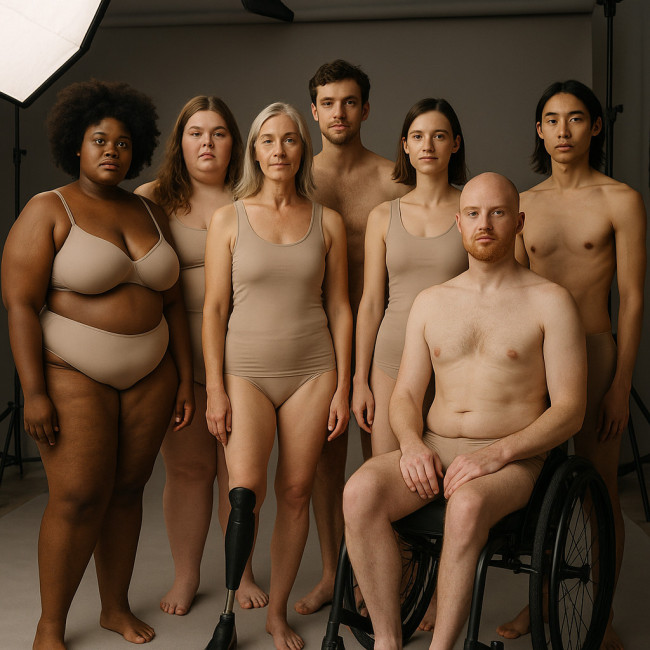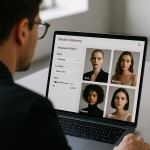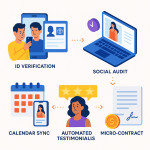Diversity checklists: building inclusive lineups through precise body data
Struggling to balance creative vision with real representation? This guide shows you how precise body data turns diversity checklists into actionable casting tools. From gathering measurements to analysing gaps, you will learn step-by-step tactics that help you build inclusive line-ups, improve brand perception and meet evolving industry standards.
Why body data outperforms gut feeling

Brilliant campaigns still encounter backlash when line-ups ignore the full spectrum of bodies. Relying on “looks right” often reproduces hidden bias. Precise body data—age, height, weight, limb difference, skin tone, disability status—gives you measurable proof that marketing truly reflects your audience. By quantifying bodies, you can run pivot-table breakdowns that reveal over- or under-representation at a glance, share benchmark dashboards with stakeholders and feed machine-learning models that predict diversity gaps before they occur. The result is a transparent, repeatable framework that beats subjective debates and accelerates compliance with regulations in multiple markets.
- Transparency: Share clear metrics with clients and compliance teams.
- Speed: Filter profiles in a global model directory, such as the global model directory, in minutes instead of weeks.
- Brand trust: Consumers see their realities on screen, boosting conversion and loyalty.
Building your diversity checklist with precise body data
1. Define representation goals first
Start with audience analytics, product sizing charts and regional demographics. List the body categories you must include—plus stretch goals that push representation forward.
- Body size range (e.g. XXS–6XL)
- Gender identities (male, female, non-binary, trans)
- Age bands (teen, 20-40, 40-60, 60+)
- Disabilities (visible and invisible)
- Ethnic backgrounds and skin tones
For deeper sizing insights, tap the research process outlined in inclusive sizing playbook.
2. Standardise measurement formats
Confusing units derail analysis. Pick one set—centimetres and kilograms, or feet/inches and pounds—and stick to it across every profile and spreadsheet.
3. Gather data during talent onboarding
Ask models to verify:
- Height, weight and body shape (with measurement date)
- Chest, waist, hip, inseam and shoe size
- Medical or physical considerations affecting fit or timing
Privacy counts. Store data in GDPR-compliant platforms and limit access to authorised team members.
4. Map current line-up vs. target mix
Before booking, visualise where you under-represent. The bar chart below compares average runway specs with real-world averages—an eye-opener when parity is off.
Source: CDC & CFDA
5. Shortlist with inclusive filters
Modern directories already offer advanced filters. Combine exact measurements, location and availability to surface fresh faces quickly. Read how inclusive sizing tags raise visibility for underrepresented talent.
6. Validate sample wardrobes
Nothing screams tokenism like booking a plus-size model but only carrying straight-size samples. Cross-reference wardrobe measurements with your model data. Build or rent garments accordingly.
7. Schedule equitable call times
Adaptive clothing changes or mobility needs can add prep time. Pad the schedule so nobody feels rushed or spotlighted for the wrong reason.
8. Capture diversity metrics post-shoot
Archive which body categories appeared in final edits vs. initial bookings. Over time you will spot systemic drop-offs—vital to fix bias in approvals, retouching and final cuts.
Quick-start diversity checklist template
| Checkpoint | Data needed | Owner | Status |
|---|---|---|---|
| Audience body map completed | Sales & census data | Marketing | |
| Measurement units standardised | Guide PDF | Production | |
| Model pool audited for gaps | Height, size, age mix sheet | Casting | |
| Wardrobe aligned with sizes | Garment matrix | Styling | |
| Equitable call times set | Timetable | AD | |
| Post-shoot metric report | Diversity KPI dashboard | Project manager |
Optimising each model category
Different bodies require tailored scouting tactics. Here are four priority areas:
Female presenting models
Use extended size and age filters to avoid clustering around “sample size 2, age 22.” Our guide on how to cast inclusive runways breaks down fit-model pipelines that embrace curves, petites and seniors.
Male presenting models
Avoid the six-pack tunnel vision. Hybrid rosters mixing muscular, plus, older and disabled men broaden consumer resonance. See how to expand brand appeal with male model rosters.
Non-binary & trans models
Respect self-identified size labels and pronouns. Offer gender-neutral changing areas and check that wardrobe notes recognise binders, prosthetics or compression wear requirements.
Disabled models
Book accessible studios early. Confirm lift availability, rest zones and any lighting triggers for epilepsy or sensory sensitivity.
Overcoming common obstacles
“Our client only wants tall, thin models.”
Counter with data showing wider engagement and stronger ROI when ads reflect audience diversity. Provide comparative click-through and sales metrics from past inclusive campaigns.
Last-minute casting gaps
Keep a standby shortlist filtered by measurement clusters. Rapid digital vetting frameworks in evaluate online submissions without bias can reduce panic bookings.
Wardrobe budget fears
Partner with rental houses that stock size diversity. Bulk negotiate; diverse garments boost reuse potential, lowering cost per shoot over time.
Interactive quiz: test your diversity-checklist readiness
FAQ
- How often should I update body data?
- Request verification every six months or immediately after significant weight, fitness or medical changes to keep your database reliable.
- Is collecting disability information legal?
- Yes, when you gather it voluntarily, store it securely and explain how the data improves accessibility. Always comply with local privacy laws.
- What KPI proves diversity success?
- Track the ratio of diverse bodies booked versus campaign goals, plus performance metrics such as engagement rate, dwell time and sales uplift compared with previous non-inclusive campaigns.
Take action today
Precise body data turns good intentions into measured progress. Audit your current line-ups, implement the checklist template and watch inclusivity drive stronger brand loyalty. Ready to scale? Explore advanced tags and filters in your model directory now.
Need deeper guidance? Our experts can tailor a data-driven casting strategy for you. Contact us to book a consultation.











